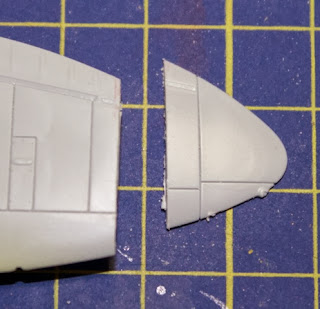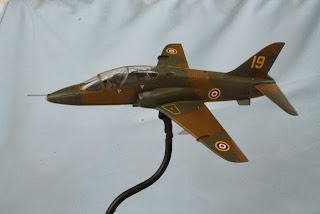Spitfire LF XVI, TB900/GE-D, 349 (Belgium) Squadron, Fassburg, 1946
This model was completed back in 2009 when my passion for Spitfires was just beginning to gain some steam. I had this Heller kit for a number of years; the instructions indicate HELLER HUMBROL.
The vintage of the kit is such that it has raised details. Until the more recent Sword XVI was released, this was the most accurate XVI in 72nd scale. Frankly, it still stands up well next to my more modern kits. It does suffer from the radiators being too deep. One modeler has suggested Heller was using photos of 349 Squadron when it flew both the XIV and XVI and made the mistake of presuming the key shots of the radiators were for the XVI.
At any rate, it's an error that is easily fixed with a razor saw. Simply cut the radiator off then reglue it. The thickness of the blade is generally enough to fix the problem. Unfortunately I wasn't aware of the problem with this kit when I built it, so did not know to fix it. I do remember that when building it I thought the radiators looked odd, but I had few (read zero) Spitfire references back then.
During construction I took care to retain the details. All was good and what little I lost along the fuselage seams was easily repaired with a hobby knife. I simply rocked it across the seam until a slight ridge of plastic came up. All sorted.
The Heller kit captures the shape very well. The shot along the fuselage axis quite nicely shows the nose could fit a Merlin. Some Spitfire kits are a bit anemic in that area.
The model is painted with Humbrol enamels. Ocean Grey is Hu106, Dark Green is Hu116 and Medium Sea Grey is Hu165. The model was coated with Future/Klear prior to decals.
Oh the decals! The kit decals are useless; even on this kit released today. The code letters are a sickly green, not Sky. The national markings are off register. I had found some Lifelike Decals, sheet 72-006, that had this scheme on it; since I wanted a Day Fighter Scheme for my first LF XVI, I decided to use these markings. I remember having absolutely no difficulty with them; I probably used Micro Set/Sol, which was my setting solutions at the time.
Overall I'm very happy with this model. It was an easy build over a few weekends and the kit looks the part. I like it so much I keep an eye out for them at shows. Typically they run $2-$3 each and are tremendous value for money at that price.
Thanks for looking…













